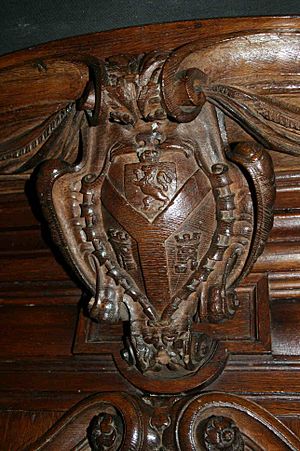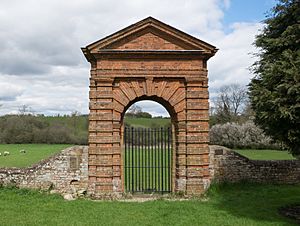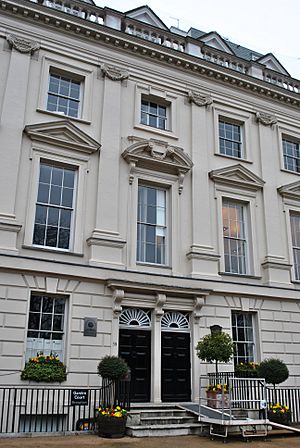David Cunningham of Auchenharvie facts for kids
David Cunningham of Auchenharvie (died 1659) was an important person in the court of Charles I of England. He owned Auchenharvie Castle in Scotland, but he spent most of his time in London. There, he worked as a courtier, which means he was a trusted helper and friend to the King. He also managed the King's money, collecting royal rents and payments. Many of his letters, which tell us a lot about his life, are kept safe in the National Records of Scotland.
Contents
Working for the Royal Family
David Cunningham was part of a group of people who worked closely with Sir Adam Newton. Sir Adam lived at Charlton House in Kent. He was also Scottish and had been the teacher for Henry Frederick, Prince of Wales, who was King Charles I's older brother.
After Prince Henry sadly passed away in 1612, David Cunningham and Sir Adam Newton continued to manage money for the royal family. They collected income from Wales and other lands. This money helped pay for Prince Charles' household. Even when Charles became King, this income stream continued to be managed by Cunningham. For example, in 1618, Cunningham paid the wages for royal musicians like Alfonso Ferrabosco and Thomas Lupo.
Helping with Royal Finances
Cunningham continued to manage money for King Charles I. In 1633, he paid Thomas Howard, 1st Earl of Berkshire £100 for keeping horses for the King. Some of his financial records are still available today. You can find them in the National Archives and at Ayrshire Archives.
These records show payments for many things. They include money for the painter Daniël Mijtens and the armourer Arnold Rotsipen. He also paid wages to the King's barber, Thomas Caldwell. Cunningham even paid for small improvements in the park at Ampthill. He also helped settle old debts from the funeral of King James, Charles I's father.
Friends and Family Connections
David Cunningham wrote letters to his cousin, David Cunningham of Robertland. This cousin was the grandson of a royal builder, David Cunningham of Robertland. In his letters, David Cunningham of Auchenharvie gave advice to his younger cousin. He talked about managing their family estates and other interests.
He also discussed taking Sir Adam Newton's son, Sir Henry Newton, on a trip to France for his education.
Rebuilding a Church
When Sir Adam Newton died in 1629, David Cunningham and Peter Newton were in charge of his will. They were asked to rebuild St Luke's Church in Charlton. David Cunningham's family crest can still be seen carved on the pulpit in the church today.
Working with Famous Builders
Nicholas Stone, a famous master builder who worked with Inigo Jones, called David Cunningham his "great good friend." Cunningham paid for monuments for important people. These included a monument for Thomas Puckering at St. Mary's in Warwick. He also paid for Sir Adam Newton's own tomb at St. Luke's Charlton.
Cunningham was also involved in the business of Sir Adam Newton's daughters, Jane Enyon and Elizabeth Peyto. Elizabeth's husband, Edward Peyto, built a house at Chesterton, Warwickshire.
Life at Court
One of Cunningham's letters describes a secret group of courtiers. This group was made up of Scottish "cubicular" or bedchamber servants. In June 1629, he hurt himself badly while playing football. Around the same time, the King asked him to oversee building work at Berkhamsted Place. His records for this work still exist. They were signed by Thomas Trevor, who managed building projects at Windsor Castle. These records are now kept at the Folger Shakespeare Library. The improvements at Berkhamsted were for Jane Murray, the widow of Secretary Murray, and her young family. This family included Anne, Lady Halkett and Elizabeth Murray, who later married Sir Adam Newton's heir, Sir Henry Newton.
Fashion and Advice
In 1633, King Charles visited Edinburgh for his coronation. David Cunningham bought clothes in London for his cousin, Sir David Cunningham of Robertland, to wear for this special event. The clothes followed the styles and colours chosen by the King's tailor, Patrick Black.
On May 1, 1633, Cunningham advised his cousin: "Sir, you didn't need to tell me to spend a lot of your money, because I'm already good at that! But I will try to keep the cost as low as I can. However, your honour and reputation are important at such an amazing time as this. I hope we won't see another event like it in my lifetime, so we shouldn't worry too much about saving money."
Helping Young Nobles
Several documents show that Sir David was allowed to pay for the education of the royal children. Cunningham was also directly involved in helping young Scottish nobles get an education. This included Hugh Montogmerie, who would later become the Earl of Eglinton, and his brothers. They came to London in November 1634 to see the city after visiting Paris. Cunningham and Sir John Seton helped them. In November 1635, Cunningham hoped to help Henry Montgomerie become a gentleman of the Prince's bedchamber.
Marriage Advice
Cunningham encouraged his cousin to marry Elizabeth Heriot. She was the daughter of a rich cloth merchant and royal financier named Robert Jousie. Elizabeth was also the widow of a goldsmith named James Heriot. In 1635, Cunningham wrote that "she is still a widow but probably won't be for long, as many important men are asking to marry her."
A Royal Masque
In 1636, Cunningham went with the King's court to Oxford. He described a special show called a masque in another letter to his cousin. In this show, pies walked around! One group of pies looked like English Bishops, led by the Archbishop of Canterbury. The other group looked like foreign Cardinals, led by the Pope. Both groups came to the King's table, one on his right and one on his left. They were both welcomed and became friends. This show seemed to represent the idea of Catholics and Protestants getting along.
Building a House
Cunningham seems to have been involved in building a house in Lincoln's Inn Fields in London. This house is now called "Lindsey House." In 1641, he sold it to Henry Murray (died 1672). Henry was a son of Secretary Murray and a servant in the King's bedchamber. The house was finished between 1639 and 1641. It is thought that Inigo Jones and Nicolas Stone might have worked on it. The building has brick pillars that look like stone. It fit the building rules of London in the 1600s.
Later Life and Legacy
In 1639, Robert Johnstone, a friend of George Heriot, named David Cunningham as the overseer of his will. He left Cunningham an Arabian gold coin. Cunningham and another supervisor, Lord Johnstone, were asked to use £3,000 for good causes in Scotland.
Around 1640, a survey of land rentals in the Cunninghame area of Ayrshire showed that David Cunningham owned land worth £1553. This made him one of the biggest landowners in that area.
In September 1651, after the King's supporters lost the battle of Worcester, David Cunningham was held as a prisoner in Chester Castle. Other important people like the Earl of Derby and the Duke of Lauderdale were also prisoners there.
David Cunningham passed away in 1659. He was buried on February 7 in Charlton, in the church he had helped to rebuild. He wrote his will on January 18. After his death, there were disagreements about his money and property. Records show that he had debts of about £6,000, but people owed him around £30,000. It took many years for his estate to be fully settled.




